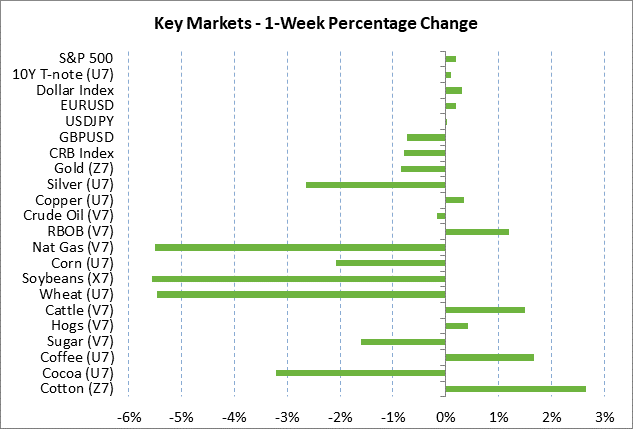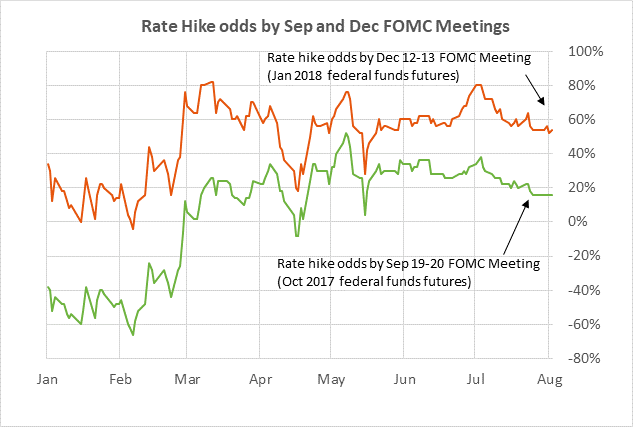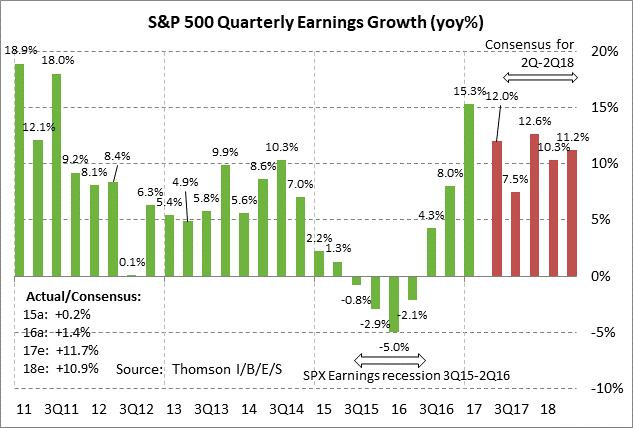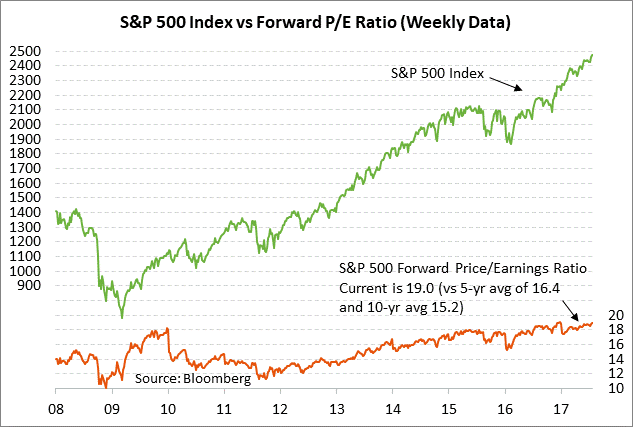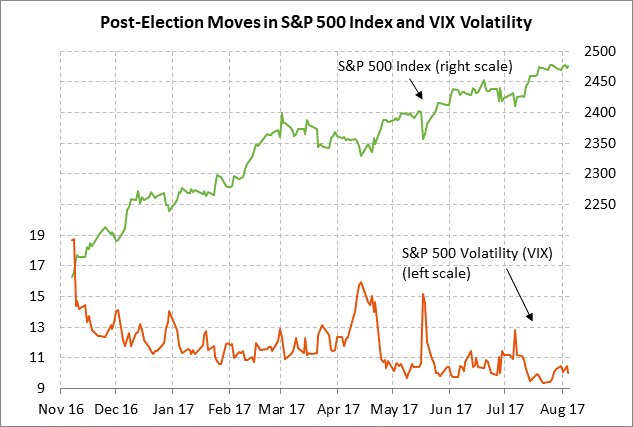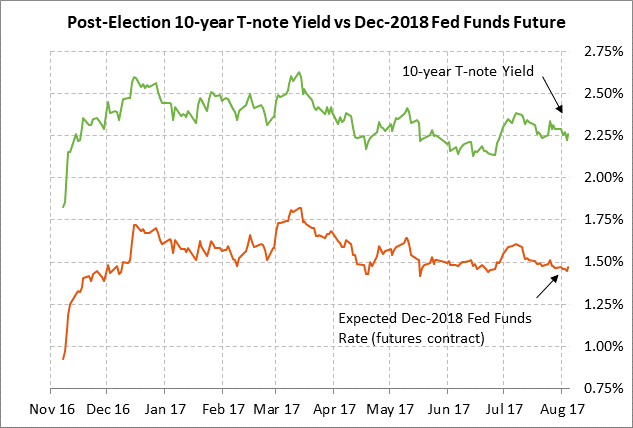- Weekly U.S. market focus
- Strong payroll report slightly boosts Fed rate-hike outlook
- Last big week for Q2 earnings
- Dollar sees sharp recovery rally
- Stock market holds gains and remains bullish
- T-notes remain mildly bullish
Weekly U.S. market focus — The U.S. markets this week will focus on (1) any fine-tuning of Fed expectations with four appearances by Fed officials this week, (2) the Treasury’s auction of $62 billion of 3-year, 10-year and 30-year securities, (3) the last busy Q2 earnings week with 110 of the S&P 500 companies scheduled to report, (4) a relatively light week for U.S. economic reports with the main focus on the PPI and CPI reports late in the week, and (5) oil prices, which are consolidating mildly below last Thursday’s 2-month high.
The markets this week will be waiting to see if North Korea lashes out with new missile tests or other provocations after the UN Security Council on Saturday approved major new sanctions aimed at cutting off $1 billion of North Korea exports. The Trump administration was pleased with China’s vote in favor of the new North Korean sanctions, which may cause the Treasury administration to back off on any new trade threats against China.
The markets this week will have some relief from Washington politics since both the House and Senate are now in recess until after Labor Day. Meanwhile, President Trump last Friday began a 17-day vacation at his Bedminster golf club in New Jersey. However, the Russian investigations will continue and could produce fresh news this week.
Strong payroll report slightly boosts Fed rate-hike outlook — Last Friday’s July unemployment report was relatively strong and caused a slightly more hawkish turn in the federal funds futures curve. Fed funds futures on Friday were unchanged for the remainder of 2017 but turned more hawkish by 2-3 bp for the 2018-2019 contracts. The market is currently discounting the odds for a rate hike at 16% for the next FOMC meeting on Sep 19-20, 20% by the Oct 31/Nov 1 meeting, and 54% by the Dec 12-13 meeting.
Last Friday’s July payroll report was solid at +209,000, stronger than market expectations of +180,000. The July unemployment rate fell by -0.1 point to match May’s 16-year low of 6.3%. The July average hourly earnings report of +2.5% y/y was unchanged from June but was slightly stronger than market expectations for a decline to +2.4%. Friday’s July unemployment report got the Q3 economic data off to a good start. The Atlanta Fed’s latest GDPNow forecast for Q3 GDP is strong at +3.7%, which would be a major improvement from the tepid growth of +1.9% seen in the first half of 2017.
Last big week for Q2 earnings — This will be the last busy week for Q2 earnings with 110 of the S&P 500 companies scheduled to report. Next week there will be only 27 SPX earnings reports and 30 reports in the following week. Q2 earnings season has been very strong with the consensus rising to +12.0% (+9.3% ex-energy) from +8.0% as of July 1, according to Thomson Reuters I/B/E/S. Of the 420 SPX companies that have already reported earnings, 72.9% have beaten their consensus, better than the long-term average of 64% and the 4-quarter average of 71%, according to Thomson. The market is expecting strong earnings growth to continue with growth expected at +11.7% in 2017 and +10.9% in 2018.
Dollar sees sharp recovery rally — The dollar index last Friday showed a sharp rally from last Wednesday’s 15-month low and closed the day up +0.76%. Friday’s rally was driven by short-covering sparked by the stronger-than-expected U.S. payroll report, which was hawkish for Fed policy and supportive for U.S. interest rate differentials. If strong U.S. economic data continues, the Fed will be encouraged to go ahead with another rate hike by year-end. The dollar may see some relief this week from Washington politics since Washington politicians are all on summer break, although there could be new Russian revelations.
The dollar also received a boost last Friday after White House economic advisor Gary Cohn said that the Republicans need to get the corporate tax rate below the average OECD rate of about 23%. In response to a question about his top priority, he said, “My No. 1 priority for now until the end of the year is taxes. My second priority is for taxes. And if you’re confused, my third priority is taxes.”
Stock market holds gains and remains bullish — The S&P 500 index last week consolidated mildly below the late-July record high. Stocks remain in bullish shape mainly because of very strong Q2 earnings growth and the prospects for continued strong earnings growth at least through 2018. The stock market has also been supported by the Fed’s more dovish turn with the recent soft inflation figures. The stock market has so far been able to shake off worries about the need for a debt ceiling hike by early to mid-October and by the political chaos in Washington. The stock market has also shrugged off high valuations with the forward P/E of 19.0 (well above the 5-year average of 16.4 and the 10-year average of 15.2). Stock market volatility remains very low with the VIX last Friday closing at 10.03%.
T-notes remain mildly bullish — Sep T-notes last Friday fell on the stronger-than-expected U.S. payroll report of +209,000 and wage report of +2.5% y/y. However, T-notes are not far below last Thursday’s 5-week high. The T-note market has rallied modestly over the past month due to more dovish perceptions of Fed policy and relief that German bund yields have eased in the past three weeks. The main bearish factor over the past 6 weeks has been the rally in oil prices and the +13 bp rise in the 10-year breakeven inflation expectations rate. The TYVIX index last Friday closed at a very low 3.74% as the market expects little action until September when Congress returns to deal with the budget and debt ceiling and the FOMC holds its next meeting on Sep 19-20.

